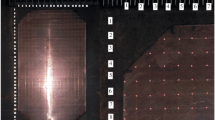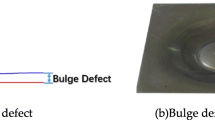Abstract
The article shows data on determining billet shape while obtaining a box-shaped part from aluminum-copper bimetallic composition. Special attention in the course of finite-element modeling of strain process is paid to the choice of mechanical characteristics of each layer and the nature of the relationship between layers. It is shown that the optimal billet shape for drawing is a “rectangle with cut angles” and copper layer outer position. This billet shape ensures the absence of corrugations with a single junction drawing of aluminum-copper bimetal box-shaped parts, and also provides the least deformation force with minimum intensity of stresses and strains. The absence of folds allows to judge on sufficiently proportionate layer-by-layer strain and preservation of the indissoluble layer-by-layer engagement. This makes possible to design a technological process for the production of bimetallic contacts with the required set of electromechanical characteristics and to recommend it for manufacturing. It is also noted that a more solid and consistent material for obtaining the optimum product handling properties should be located on the outer layer of the part. At the same time, it is advisable to use drawing in the manufacture of bimetallic parts to select, whenever it is possible, materials with approximately the same strength and plastic characteristics, avoiding the occurrence of different stresses in the product layers and, accordingly, distortion or other negative consequences for the finished item. The presence of lamination in a bimetallic composition increases the electrical resistance hundredfold and leads to the product rejection.
Access this chapter
Tax calculation will be finalised at checkout
Purchases are for personal use only
Similar content being viewed by others
References
Li, H., Cao, B., Liu, J., Yang, J.: Modeling of high-power ultrasonic welding of Cu/Al joint. Int. J. Adv. Manufact. Technol. 97(1–4), 833–844 (2018)
Asemabadi, M., Sedighi, M., Honarpisheh, M.: Investigation of cold rolling influence on the mechanical properties of explosive-welded Al/Cu bimetal. Mater. Sci. Eng. 558, 144–149 (2012)
Khosravifard, A., Ebrahimi, R.: Investigation of parameters affecting interface strength in Al/Cu clad bimetal rod extrusion process. Mater. Des. 31, 493–499 (2010)
Puzyr, R., Haikova, T., Majerník, J., Karkova, M., Kmec, J.: Experimental study of the process of radial rotation profiling of wheel rims resulting in formation and technological flattening of the corrugations. Manufact. Technol. 18(1), 106–111 (2018)
Zhang, R., Lang, L., Zafar, R., Lin, L., Zhang, W.: Investigation into thinning and spring back of multilayer metal forming using hydro-mechanical deep drawing (HMDD) for lightweight parts. Int. J. Adv. Manufact. Technol. 82(5–8), 817–826 (2016)
Puzyr, R., Haikova, T., Trotsko, O., Argat, R.: Determining experimentally the stress-strained state in the radial rotary method of obtaining wheels rims. East. Eur. J. Enterp. Technol. 4(1(82)), 52–60 (2016)
Akbari-Mousavi, S., Barrett, L., Al-Hassani, S.: Explosive welding of metal plates. J. Mater. Process. Technol. 202(1–3), 224–239 (2008)
Maslov, A., Batsaikhan, J., Puzyr, R., Salenko, Y.: The determination of the parameters of a vibration machine the internal compaction of concrete mixtures. Int. J. Eng. Technol. 7(4.3), 12–19 (2018)
Hassan, M.A., Ahmed, K.I.E., Takakura, N.: A developed process for deep drawing of metal foil square cups. J. Mater. Process. Technol. 212, 295–307 (2012)
Puzyr, R., Savelov, D., Shchetynin, V., Levchenko, R., Haikova, T., Kravchenko, S., Yasko, S., Argat, R., Sira, Y., Shchipkovakyi, Y.: Development of a method to determine deformations in the manufacture of a vehicle wheel rim. East. Eur. J. Enterp. Technol. 4(1(94)), 55–60 (2018)
Harpell, E., Worswickb, M., Finn, M., Jain, M., Martin, P.: Numerical prediction of the limiting draw ratio for aluminum alloy sheet. J. Mater. Process. Technol. 100, 131–141 (2000)
Akbulut, H.: On optimization of a car rim using finite element method. Finite Elem. Anal. Des. 39, 433–443 (2003)
Kholiavik, O.: Development of the analytical method for calculating the size and shape of the billets for box-shaped parts drawing, “KPI”, Kyiv (2013)
Boris, R., Kholiavik, O., Vyshnevsky, P.: Calculation of stressed-deformed state during drawing with the thawing of two-layer metal. Sci. Rev. 7, 40–47 (2017)
Savelov, D., Dragobetsky, V., Puzyr, R., Markevych, A.: Peculiarities of vibrational press dynamics with hard-elastic restraints in the working regime of metal powders molding. Metall. Min. Indus. 2, 67–74 (2015)
Camacho, A., Veganzones, M., Claver, J., Martín, F., Sevilla, L., Sebastián, M.: Determination of actual friction factors in metal forming under heavy loaded regimes combining experimental and numerical analysis. Materials 9, 751 (2016)
Geselbracht, M.J., Ellis, A.B., Penn, R.L., Lisensky, G.C., Stone, D.S.: Mechanical properties of metals: experiments with steel, copper, tin, zinc, and soap bubbles. J. Chem. Educ. 71(3), 254 (1994)
Puzyr, R., Kukhar, V., Maslov, A., Shchipkovskyi, Y.: The development of the method for the calculation of the shaping force in the production of vehicle wheel rims. Int. J. Eng. Technol. 7(4.3), 30–34 (2018)
Matsuda, K., Hashimoto, D., Nakamura, K.: Real contact area and friction property of rubber with two-dimensional regular wavy surface. Tribol. Int. 93(part B), 523–529 (2016)
Wagener, H.W., Wolf, J.: Coefficient of friction in cold extrusion. J. Mater. Process. Technol. 44, 283–291 (1994)
Wang, L., Cai, J., Zhou, J., Duszczyk, J.: Characteristics of the friction between aluminium and steel at elevated temperatures during ball-on-disc tests. TribolLett 36, 183–190 (2009)
Nuruzzaman, D.M., Chowdhury, M.A.: Friction coefficient and wear rate of copper and aluminum sliding against mild steel. Int. Trans. J. Eng. Manag. Appl. Sci. Technol. 4(1), 29–40 (2013)
Nuruzzaman, D., Chowdhury, M.: Effect of normal load and sliding velocity on friction coefficient of aluminum sliding against different pin materials. Am. J. Mater. Sci. 2, 26–31 (2012)
Maltseva, L., Sharapova, V., Maltseva, T., Tushlyaeva, D., Lozkin, N., Pastukhov M.: Study of structural transformations occurring in the metal composite after explosion welding. In: The 2012 World Congress on Advances in Civil, Environmental, and Materials Research (ACEM’12), pp. 1889–1899. Seoul, Korea (2012)
Ghizdavu, V.: Explosive welding of copper to steel. In: International Conference of Scientific Paper, pp. 876–881. Brasov (2011)
Sinmazcelik, T., Avcu, E., Bora, M.O., Coban, O.: A review: fibre metal laminates, background, bonding types and applied test methods. Mater. Des. 32, 3671–3685 (2011)
Kalyanasundaram, S., DharMalingam, S., Venkatesan, S., Sexton, A.: Effect of process parameters during forming of self reinforced–PP based fiber metal laminate. Compos. Struct. 97, 332–337 (2013)
Ahmadi, A., Toroghinejad, M.R., Najafizadeh, A.: Evaluation of microstructure and mechanical properties of Al/Al2O3/SiC hybrid composite fabricated by accumulative roll bonding process. Mater. Des. 53, 13–19 (2014)
Bagherzadeh, S., Mollaei-Dariani, B., Malekzadeh, K.: Theoretical study on hydro-mechanical deep drawing process of bimetallic sheets and experimental observations. J. Mater. Process. Technol. 212, 1840–1849 (2012)
Eslami, A.H., MojtabaZebarjad, S., Moshksar, M.M.: Study on mechanical and magnetic properties of Cu/Ni multilayer composite fabricated by accumulative roll bonding process. Mater. Sci. Technol. 29, 1000–1005 (2013)
Author information
Authors and Affiliations
Corresponding author
Editor information
Editors and Affiliations
Rights and permissions
Copyright information
© 2020 Springer Nature Switzerland AG
About this paper
Cite this paper
Haikova, T., Puzyr, R., Dragobetsky, V., Symonova, A., Vakylenko, R. (2020). Finite-Element Model of Bimetal Billet Strain Obtaining Box-Shaped Parts by Means of Drawing. In: Ivanov, V., et al. Advances in Design, Simulation and Manufacturing II. DSMIE 2019. Lecture Notes in Mechanical Engineering. Springer, Cham. https://doi.org/10.1007/978-3-030-22365-6_9
Download citation
DOI: https://doi.org/10.1007/978-3-030-22365-6_9
Published:
Publisher Name: Springer, Cham
Print ISBN: 978-3-030-22364-9
Online ISBN: 978-3-030-22365-6
eBook Packages: EngineeringEngineering (R0)




